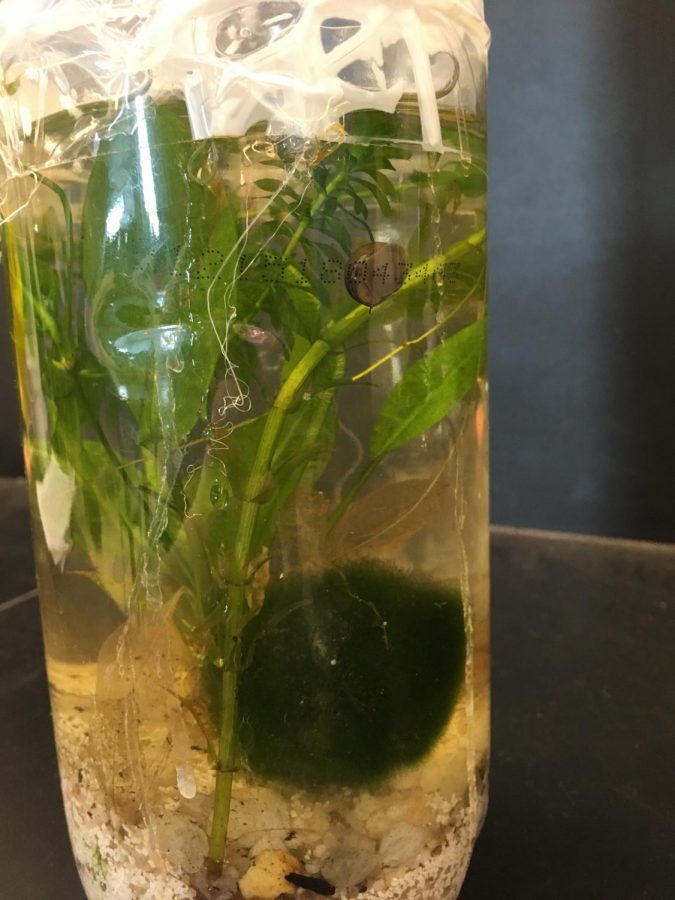The importance of sustainability
The concept of environmental sustainability is a topic that is rarely spoken of in everyday conversation. It has been a notable trend that the general public takes it for granted, and merely assumes that the environment will keep functioning and working to benefit the people of the world. The students in Ms. Sotomayor’s International Baccalaureate (IB) Biology classes recently worked on a project that allowed them to study and analyze environmental sustainability. The project involved the creation and maintenance of eco-columns: artificial chambers containing a multitude of organisms that simulate natural ecosystems.
“I originally thought achieving sustainability would be easy, considering how many pollutants humans put into into the environment on a daily basis.” senior Aneese Kouar said.
The goal of the project was to create a sustainable environment for the organisms living in the eco-columns, an environment where the organisms would thrive without human influence. The concept seemed simple to Ms. Sotomayor’s students at first, as they look around and see sustainable ecosystems every day. However, creating a sustainable environment in the eco-columns proved to be a much more challenging task than many students anticipated.
“The eco-column was difficult to maintain because if so much as one chamber wasn’t near perfect, the entire column would get thrown into chaos.” Kouar said.
Ms. Sotomayor’s students learned of all the necessities that contributed to a sustainable environment over the course of the project. They were, however, unaware of a lot of these necessities when the project was first assigned, creating some initial issues with some of the students’ eco-columns. A setback faced by a lot of students during the early days of the project was the fact that their crickets in their terrestrial (ground level) chambers were dying consistently due to lack of water.
The problems maintaining the ecosystems only grew from there, especially in the aquatic chambers of the eco-columns. The consensus among Ms. Sotomayor’s students was that this chamber was by far the most difficult to maintain. This was due to the long list of water contents that needed to be kept within safe parameters so that the aquatic organisms, both animals and plants, could survive. These water contents include dissolved oxygen, nitrite and nitrate levels, ammonia, chlorine and many others. For some of Ms. Sotomayor’s students, keeping all these water contents at ideal levels to ensure the sustainability of their aquatic ecosystems was a difficult balancing act. For some students, it seemed as if one of these levels was always fluctuating beyond ideal parameters, no matter what adjustments were made to correct them.
“It was very difficult to maintain the eco-column,” senior Anna Humphries said. “The hardest part in my opinion was the oxygen levels in the water and trying to raise them in order to maintain life.”
It took all of these students at least a couple of weeks, as well as a lot of tinkering, adjustments, add-ons, and replacements to their eco-columns to reach sustainability. It involved an unexpected level of difficulty, but most of Ms. Sotomayor’s students were eventually able to strike a perfect balance in all three of their chambers to ensure sustainable ecosystems within their eco-columns. The achievement of sustainability came with a feeling of great victory for these students, but also caused them to reflect on the difficulty involved in this achievement, and the real world applications that this difficulty has.
“This experiment helped me learn about how difficult it is for the earth’s ecosystem to handle the amount of toxic materials humans release into it.” Kouar said.
The IB Biology sustainability project opened the eyes of Ms. Sotomayor’s students to the complexity of the world’s ecosystem, and how difficult it is for this ecosystem to maintain itself. The lesson learned by many of these students throughout this project was that the functions of our environment are not something to be taken for granted. It is a careful balance that is involved in the sustainability of the environment, and the students now realize that sustainability and the environment are things to be greatly cared for.
“I think that as a society, we don’t think of sustainability as a serious priority,” Humphries said. “I think that nowadays with climate change becoming more public and with more research coming out, people are starting to pay more attention to sustainability, which is good because although people don’t realize it, it’s a huge part of our lives.”








